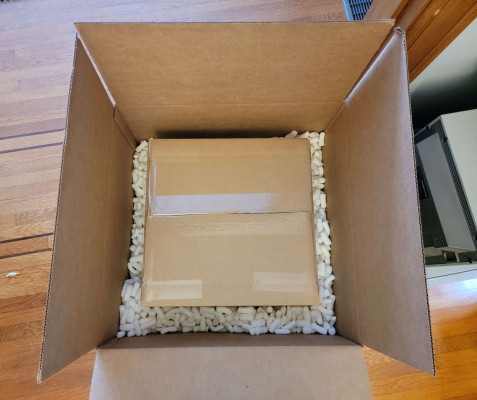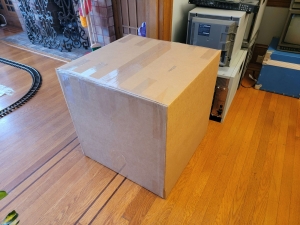The advice for shipping varies depending on the size, shape, and weight.
Table of Contents
Here is an Amazon link to the Instapak I use: https://www.amazon.com/dp/B01BU5VYRQ. There are other ways to create expanding-foam in packages but they require additional tools like a heat gun and generally its a lot more complicated. Experienced warehouse sellers on eBay already have this kind of equipment and are probably going to use it if you order a CRT from them. It works very well - I've had 13" CRTs (Both plastic and metal chassis) delivered from Japan to USA safely using nothing but expanding foam.
- Don't use expedited shipping services such as "Overnight" to ship CRTs. The faster a package moves through the shipping network the higher the likelihood it will get thrown around and damaged. Just use standard ground service through a wholesale site such as PirateShip.com
- Don't rely on shipping insurance to pay out in the event of damage - shipping claims almost never rule in your favor and you will never be compensated for the cost of the CRT in the event of damage.
- If you don't think the CRT will survive shipping... don't ship it! Arrange other delivery such as freight or U-Ship.
8" PVMs
Despite being the smallest and lightest to ship, these can be a challenge because finding a thick rectangular box can be difficult. In the past I've cut down boxes to make my own but this is very time consuming. If you find a source for rectangular boxes that fit PVMs please send it to me :)
As far as packing materials, I have seen people have decent success wrapping the PVM in several layers of bubble wrap and then surrounding it with packing peanuts. However, my personal reccomendation is to use Instapak.
It only takes two sheets of Instapak, one on the front of the monitor and one on the back. 8" PVMs are built to be portable, so they can withstand some rough handling. I wouldn't worry too much about packing these as long as you use enough materials and a strong box. Make sure your box is at least 2" larger than the PVM in all directions, and no bigger than 4" larger in any direction.
13" PVMs
Sony PVMs with Plastic Back Panels
My usual method for shipping monitors is to just use a double-walled brand new box and Instapak expanding foam on all 8 corners to make a perfect snug fit around the monitor.
However Sony's bone-headed decision to use a plastic panel held on by plastic rivets for the back of their PVMs made me apprehensive about relying solely on that method. If the shipping company dropped it on the plastic side there's a good chance it would not withstand the impact. There's a HUGE risk factor on any impact directed towards that plastic side because at best you're going to end up with broken rivets, at worst you're going to end up with a necked tube. If you're lucky it will only break the neckboard and not the tube itself.
90% of the Sony PVMs I've seen people ship from eBay aren't using adequate packing materials and therefore arrive with the back panel broken, the front corner handles broken, and often have internal PCB damage. This is leading to an unnecessary reduction in the amount of remaining working CRTs left, and often the ones being broken are high-end or otherwise-rare examples that couldn't be sourced locally.
What I ended up doing was starting with my standard packing method of a double-walled box and Instapak (see the section below this one for instructions). Then I buy the next-size-up in box (just regular single-walled this time), fill the bottom with about 2-3 inches of packing peanuts (update: I have been advised that "60lb corrugated paper" would be an even better option than peanuts, if you can source it), then place the double walled box inside the bigger box like a matryoshka doll. Then I finish it by filling all the gaps with packing peanuts.
My thinking here is similar to when you do an egg drop test in gradeschool - the more impact absorption you can surround your tightly packed egg with, the better chance it has of remaining unharmed.
If they drop the box on any side, the soft/weak single walled box will take the beating, and the inner layer of packing peanuts will allow the tightly packed PVM inside to shift around safely without banging against anything.
Total cost of packing materials for this example was $80 ($30 DW 18x18x18 box, $10 24x24x24 SW box, $40 10-pack of instapak) and international air shipping to Canada was $199 Express Air via UPS. They could have also done $100 standard UPS.
So, with the cheapest shipping that would be $180 with label and materials. Not bad, certainly cheaper than freight shipping. U-Ship costs range drastically but typically start around double that price. U-Ship allows you to contract an individual that caravans your package all the way to its destination while making stops for other packages along the way. Compared with common ground shipping options like UPS / FedEx / USPS, the advantages are fewer times the package changes hands and no factory conveyer belts have to drop your box. Higher chance of safe arrival.
Other brands with metal backs or otherwise structurally-sound backs (i.e. no plastic rivets)
In these cases I just use 8 sheets of instapack (one for each corner of the PVM) and one box. Buy a double-walled box (you can find these at most shipping stores for about $30) that's at least 2" larger (but no more than 4") than the monitor in all directions. The double-walled carboard is important for impact absorption and structural integrity. The instapack inside will keep the monitor from shifting around or hitting the floor when the box is dropped, and it will keep it from breaking in the corners.
20" and larger PVMs
These should be shipped via frieght service such as U-Ship. They are too big and heavy for any standard courier service to handle properly without damage. If the freight service requires it to be boxed, pack it in a box with Insta-Pak like a 13" PVM. Otherwise just put a clean towel plus a few sheets of carboard over the tube to protect the glass from scratches and then wrap the whole thing with shipping shrink wrap. Some freight services might require you to also place it on a pallet.



 This work is licensed under a
This work is licensed under a